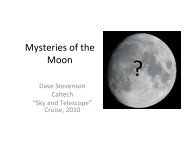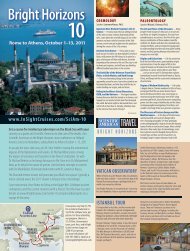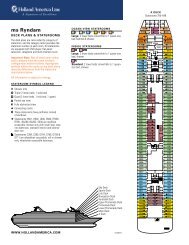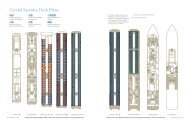flyer - Insight Cruises
flyer - Insight Cruises
flyer - Insight Cruises
You also want an ePaper? Increase the reach of your titles
YUMPU automatically turns print PDFs into web optimized ePapers that Google loves.
Bright Horizons8<br />
W. M E D I T E R R A N E A N<br />
Barcelona<br />
SAVONA<br />
Lisbon<br />
Valencia<br />
Cadiz<br />
Malaga<br />
October 28th – November 6th, 2010<br />
w w w . I n S i g h t C r u i s e s . c o m / S c i A m 8<br />
Seek out uncharted territory and revisit classic science<br />
in a Western Mediterranean whirl on Bright Horizons 8. Join a<br />
cadre of experts who share critical traits — juggling the pragmatic<br />
and the possible, driven to challenge the status quo. Foster your<br />
need to know. Explore Iberia, where science went mainstream in<br />
medieval times. Venture into Casablanca with a companion, and<br />
chart the geometry of North Africa.<br />
Gravitate to a new understanding of magnetism’s role in terrestrial and<br />
scientific exploration. Absorb the cultural importance of space exploration and<br />
implications of our new comprehension of space and time. Ponder nature’s<br />
preference for matter over antimatter, and the superlatives of CERN’s Large<br />
Hadron Collider. Practice mind over matter thinking about the structure and<br />
function of the brain. Unfold the story behind the science with cutting edge,<br />
Nobel-grade ribosomal knowledge.<br />
Carpe diem. Set a course beyond the obvious and gain insights and new<br />
angles into space exploration, neuroscience, particle physics, ribosomes, and<br />
magnetism. Join the Bright Horizons 8 community on Costa <strong>Cruises</strong>’ mv Magica<br />
October 28 – November 6, 2010. Plan now to share tapas with a friend, explore<br />
a Moroccan kasbah, and advance your science agenda. Get the details at<br />
InSight<strong>Cruises</strong>.com/SciAm-8 or call Neil or Theresa at 650-787-5665.<br />
PARTICLE PHYSICS<br />
Speaker: James Gillies, Ph.D.<br />
Casablanca<br />
Particle Physics: Using Small Particles to<br />
Answer The Big Questions — Particle physics is<br />
the study of the smallest indivisible pieces of matter<br />
— and the forces that act between them. Join<br />
Dr. Gillies and catch up on the state of the art and<br />
challenges ahead as physicists continue a journey<br />
that started with Newton’s description of gravity.<br />
We’ll look at the masses of fundamental particles,<br />
dark matter, antimatter, and the nature of matter<br />
at the beginning time.<br />
The Large Hadron Collider: the World’s Most<br />
Complex Machine — The LHC is a machine of<br />
superlatives — a triumph of human ingenuity,<br />
possibly the most complex machine ever built.<br />
James Gillies traces particle physics technologies<br />
from the invention of particle accelerators in<br />
the 1920s to today, and then focuses on the LHC<br />
itself. You’ll get a perspective on how these tools<br />
have allowed us to make phenomenal progress in<br />
understanding the Universe, and how they have<br />
revolutionized our everyday lives.<br />
THE AMA ZING BRAIN<br />
Speaker: Jeanette J. Norden, Ph.D.<br />
General Organization of the Central Nervous<br />
System — We begin with an introduction on how<br />
the central nervous system is divided into structural<br />
and functional areas. This knowledge will allow us<br />
to understand why after a stroke an individual might<br />
be blind, but not know it; why an individual might<br />
lose the ability to speak, but not to understand<br />
language; why an individual might be able to<br />
describe his wife’s face, but not be able to pick her<br />
out from a crowd.<br />
Cellular and Molecular Organization of the<br />
Central Nervous System — In this session we<br />
will focus on the structure of individual neurons<br />
and on how neurons in the central nervous system<br />
are believed to be connected to each other by an<br />
estimated 100 trillion synapses. This understanding<br />
of the structure of individual neurons and on how<br />
neurons communicate with each other allows us to<br />
have insight into disorders as diverse as depression<br />
and multiple sclerosis.<br />
Parkinson’s Disease and Other Disorders of<br />
the Motor System — Movement is a complex<br />
behavior controlled by a number of different<br />
subsystems in the brain and spinal cord. Knowing<br />
what each of these subsys tems do to allow us to<br />
move will provide the knowledge necessary to<br />
understand the loss of normal motor movement<br />
in Parkinson’s disease, spinal cord injury, and other<br />
disorders of the motor system.<br />
Angels, Demons, Black Holes, and Other<br />
Myths: Demystifying the LHC — Along with<br />
humankind’s natural curiosity comes a fear of the<br />
unknown. As LHC’s first beam day approached in Alzheimer’s Disease — Alzheimer’s disease is<br />
2008, a handful of self-proclaimed experts struck up the most common neurodegenerative disease in<br />
an end-of-the-world tune — and the whole world the United States. We will explore what is currently<br />
knew they were there. Like its predecessors, the known about this devastating disorder, and about<br />
Large Electron-Positron Collider (LEP) and Relativistic the specific areas of the brain which are affected.<br />
Heavy Ion Collider (RHIC), the LHC never posed the Next we discuss the risk factors associated with<br />
slightest risk to humanity. However, the dangerous Alzheimer’s disease. Finally, we will end this lecture<br />
scientist has always made for a good story and series with a discussion of what you can do to<br />
that’s something that Dan Brown exploited to the decrease your risk of getting this disease and on how<br />
full when writing Angels and Demons. Dr. Gillies to keep your brain healthy!<br />
will cover the fact behind the fiction of Angels and<br />
Demons and black holes at the LHC, and share the<br />
behind-the-scenes on how CERN lived with the hype. CST# 2065380-40
ASTRONOMY<br />
Speaker: Steven Dick, Ph.D.<br />
Life on Other Worlds — It’s a unique time in<br />
human history as we explore for life beyond Earth.<br />
Where do we stand in the search for life, both inside<br />
the solar system and beyond? And what would<br />
be the impact of the discovery of extraterrestrial<br />
intelligence on our society? Dr. Dick’s answers will<br />
beget more questions — get in on the discussion!<br />
A Tour of the Universe: Astronomy’s Three<br />
Kingdoms — Our view of the universe has evolved<br />
over the last century, from a static anthropocentric<br />
cosmos a few thousand light years across to a<br />
dynamically evolving universe spanning billions<br />
of light years. We’ve discovered cosmic objects like<br />
pulsars, quasars, and black holes. Travel with Dr. Dick<br />
through billions of light years of space and time as<br />
we explore the discovery and classification of objects<br />
in astronomy’s three kingdoms: the planets, the<br />
stars, and the galaxies.<br />
Exploration, Discovery, and Culture: The<br />
Importance of the Space Age — Fifty years<br />
into the Space Age and 40 years after the Apollo<br />
program put 12 men on the Moon, exploration is at<br />
a turning point. Should humans return to the Moon<br />
and go to Mars? Are robotic emissaries enough?<br />
What motivates spaceflight? Should we spend<br />
money on space with so many problems on Earth?<br />
Join Dr. Dick in contemplation of the importance of<br />
exploration to culture.<br />
Cosmic Evolution and Human Destiny —<br />
We now see the universe in the context of 13.7 billion<br />
years of cosmic evolution. What are the implications<br />
of this understanding of space and time in the short<br />
and long term? How does it affect our religions<br />
and philosophies? What is the long-term destiny of<br />
humans? Join us in a journey through science fiction,<br />
science fact, and scientific extrapolation as we<br />
ponder human destiny in a new context.<br />
MAGNETS<br />
Speaker:<br />
Michael Coey, Ph.D.<br />
What the Ancients Knew — The mysterious<br />
behavior of lodestones — rocks naturally magnetized<br />
by lightning strikes — and their strange love for<br />
iron was known in ancient China, Greece, Sumer, and<br />
Mesoamerica. The directional property was used<br />
first for geomancy and then, a millennium later, for<br />
navigation. The great voyages of discovery of Africa<br />
by the Chinese and America by the Europeans all<br />
depended on the compass. The ancients dreamt of<br />
levitation and perpetual motion. So do we.<br />
Science Rules the Earth: OK? — Robustly<br />
polemical, but insistently evidence-based, William<br />
Gilbert’s De Magnete (c. 1600) was the first modern<br />
scientific text. His insight that the Earth was a great<br />
magnet and insistence that data trumps speculation<br />
led to the heroic magnetic crusade of the 1830s,<br />
an understanding of how the Earth moves by plate<br />
tectonics, sunspots, and a way to date pottery. Join<br />
Dr. Coey and learn how science trumped charlatans<br />
with the truth and predictive power of their “magic”.<br />
The End of an Aether — The modern world<br />
began in 1820, when Hans-Christian Oersted stumbled<br />
on the connection between electricity and magnetism.<br />
The news spread like wildfire across Europe<br />
as electromagnetism spawned motors and generators,<br />
electric trains and mains power, telegraphs, radio<br />
and magnetic recording — all before 1900. If<br />
Maxwell’s equations were the greatest intellectual<br />
achievement of the century, the origin of magnetism<br />
was one of its greatest puzzles — a puzzle that<br />
could only be understood with relativity, quantum<br />
mechanics, and Dirac’s electrons with spin.<br />
Billions of Magnets for Billions of People:<br />
How and Why — When the magnet shape barrier<br />
was shattered in 1950, the technology that serves<br />
our modern lives could emerge. Tune in and learn<br />
about the small, powerful rare-earth magnets that<br />
power countless gadgets and one of the greatest<br />
modern scientific miracles — magnetic recording.<br />
Why and how have magnets have multiplied a<br />
billion-fold? Is it true that today we now make more<br />
magnets than we grow grains of rice? Dr. Coey will<br />
give you the answers to these questions, plus those<br />
to questions you hadn’t even pondered.<br />
Cruise prices vary from $969 for an Inside<br />
Stateroom to $2,829 for a Full Suite, per person.<br />
For those attending our program, there is a<br />
$1,375 fee. Government taxes, port fees, and<br />
InSight <strong>Cruises</strong>’ service charge are $270 per<br />
person. For more info contact Neil at<br />
650-787-5665 or neil@InSight<strong>Cruises</strong>.com<br />
Private, Insider’s Tour of CERN<br />
October 25, 10am–4pm — From the tiniest<br />
constituents of matter to the immensity of the<br />
cosmos, discover the wonders of science and<br />
technology at CERN. Join Bright Horizons for a private<br />
pre-cruise, custom, full-day tour of this iconic facility.<br />
Whether you lean toward concept or application<br />
there’s much to pique your curiosity. Discover the<br />
excitement of fundamental research and get a<br />
behind-the-scenes, insider’s look of the world’s<br />
largest particle physics laboratory.<br />
This trip is limited to 50 people. For questions<br />
and hotel pricing, please contact Neil or Theresa,<br />
or give us a call at (650) 787-5667.<br />
THE GEOLOGY OF THE<br />
MEDITERRANEAN BASIN<br />
Speaker: Zvi Ben-Avraham, Ph.D.<br />
Tectonics of Continental Margins Around the<br />
Eastern Mediterranean Sea — We know the<br />
fate of the Mediterranean basin. Nestled in the midst<br />
of Africa-Eurasia convergence, it is progressively<br />
shrinking and will eventually vanish. Basin margins<br />
record these dramatic events. The Mediterranean<br />
seafloor is being consumed, sliding northward under<br />
the seismically active Calabrian, Ionic, Hellenic,<br />
and Cyprian margins. Tune in to Dr. Ben-Avraham’s<br />
discussion of the geological, ecological, and human<br />
consequences of the geological evolution of the<br />
Mediterranean basin.<br />
The Dead Sea Fault and its Effect on<br />
Civilization — The Dead Sea fault (DSF) is the<br />
most impressive geological feature in the Middle<br />
East. It is a plate boundary, which transfers sea floor<br />
spreading in the Red Sea to the Taurus collision zone<br />
in eastern Turkey. The DSF is an important part of the<br />
corridor through which hominids set off out of Africa.<br />
Join Dr. Ben-Avraham for a look at the remarkable<br />
paleoseismic history of the DSF, going back about<br />
70,000 years. Learn how geological activity affected<br />
human history and politics in ancient days, and how<br />
the interplay of geology, ecosystem, and human<br />
activity are of ongoing concern and discussion.<br />
Our full day will be led by a CERN official and physicist.<br />
We’ll have an orientation; visit an accelerator and<br />
experiment; get a sense of the mechanics of the<br />
large hadron collider (LHC); make a refueling stop<br />
for lunch in the Globe of Science and Innovation;<br />
and have time to peruse exhibits and media on the<br />
history of CERN and the nature of its work.<br />
To take advantage of this unrivaled insider access<br />
to CERN, rendezvous on October 25, 2010 in Geneva,<br />
Switzerland. The additional price is $175 and includes<br />
• Entrance to CERN • Lunch at CERN<br />
• A round-trip transfer from our Geneva hotel to CERN<br />
• And then on October 27, the transfer from our hotel<br />
to Genoa, Italy.<br />
PARTICLE PHYSICS<br />
IN TREATING C ANCER<br />
Speaker: James Welsh, M.D.<br />
Subatomic Frontiers of Radiation Therapy<br />
The connection between quarks and cancer therapy<br />
might at first appear a bit obscure but hadrons may<br />
prove to be a critical component of twenty-first<br />
century oncology. In this lecture we shall review<br />
the basic molecular and cellular mechanisms<br />
whereby normal cells transform into cancer cells<br />
and then discuss some of the means through which<br />
this understanding has been exploited, such as<br />
the advent of the molecular targeted therapies.<br />
We shall then briefly review some principles of<br />
radiobiology and radiation therapy. Finally we<br />
will review some basics of the Standard Model<br />
and how this relates to the next frontier in cancer<br />
management — hadron therapy.
















